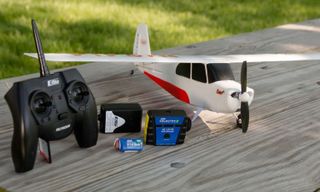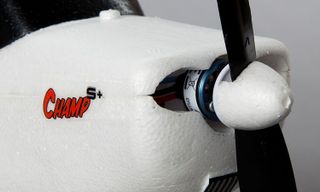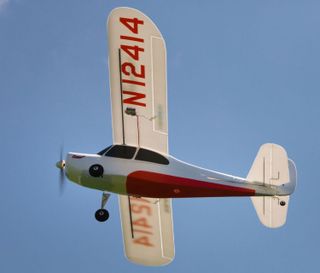HobbyZone Champ S+ RTF Drone Review: Cheap, Easy Flier
The Champ S+ offers an alternative to the ubiquitous quadcopters of the drone world, and is easy to use and fly.
Why you can trust Tom's Guide

When you hear the word "drone," you might think of the familiar quadcopter with four rotors keeping the device hovering in midair. But a drone can be any flying vehicle that relies on computer control. Fixed-wing airplanes like the $169.99 HobbyZone Champ S+ RTF and the upcoming $1,299 Parrot Disco drone definitely qualify as drones. These propeller-driven airplanes use GPS to offer smart features such as automatic landing, holding patterns and multiple smart flight modes. We are still waiting to get a full hands-on with the Disco (you can read our hands-on preview of the Disco here), but the Champ S+ is an inexpensive fixed-wing drone that is a cinch to fly, especially with the optional first-person view (FPV) kit that we tested.
Design
The Champ S+ is made of polystyrene, and has just a handful of electrical components. That explains how, despite having a wingspan of just under 24 inches, it weighs less than 4 ounces. Even the electrical bits are light: The servo motors that move the flaps weigh just over 2 grams, and the small 280-mAh battery that sits under a hatch in the base of the body weighs just 0.6 ounces. This weight doesn't allow much space for frills; the details on the frame are simply painted on, and the parts are held together with tape. It looks somewhat lashed together — but it's all about reducing the weight, and it's a very effective approach.

It all feels a bit fragile, though. On our first flight, the cover that held the battery in place fell off, and we had to use tape to hold it in place. The foam body also proved fragile: In a low-speed collision with a fence, we managed to break the propeller and the motor behind it, crush the nose, and break off the rudder. But, to be fair, most of these were fixable with a bit of tape and glue; new propellers and motors are also cheap (more on this later).

If you are using the optional first-person view (FPV) kit, the camera attaches to the top of the plane body, with a cable running down to the controller and battery in the small cavity behind it. The tiny camera is a little less than an inch and a half tall, including the antenna, and weighs just a few grams, so it doesn't affect the flight of the plane significantly.
Specs
Propeller: 1, replaceable, 5-inch diameter
Battery
Size: 280-mAh Li-ion polymer
Battery Life: 12 minutes (tested)
Size: 27 x 18 x 7 inches
Smartphone connected: No
FAA registration required: No
Weight: 3.9 ounces
MORE: The Best Drones and Quadcopters on Any Budget
Controller
The DSMX controller that comes with the Champ S+ is a bit more substantial than the drone itself, but not by much. Slightly larger than a typical game controller, it has two control sticks and a number of small buttons. Some of these buttons perform multiple features: Press the right shoulder button once, and the plane enters holding pattern (HP) mode, where it flies in a circle around you. Press and hold the button, and the plane enters auto-landing (AL) mode, where it automatically returns to the takeoff point and lands.
On our first flight, the cover that held the battery in place fell off, and we had to use tape to hold it in place.
On the left shoulder is a three-way switch for the flight mode. This lets you switch among Beginner, Intermediate and Experienced modes. We'll discuss these modes in depth later, but in short, the beginner mode tries to protect you from crashing the plane.
Flying
The box of the Champ S+ proudly proclaims that "anyone can fly this plane," and that much is true. The plane is very easy to fly, especially in the Beginner mode. Here, the plane protects you from performing overly sharp maneuvers or going too fast or too slow, by limiting how much you can pitch (tilt it forward/backward) and roll the plane left and right. And if you do lose control, just release the control sticks, and the plane will reorient itself to fly straight and level. There is also a virtual-fence feature: If you fly more than 450 feet away from the controller, the plane will turn around and fly back toward the controller. That's definitely an option I wish I had when I first learned to fly planes like this years ago; it's like learning to drive in a dual-control car with an experienced instructor by your side.

The Champ S+ is a lot of fun to fly, with light, responsive controls. When you touch one of the control sticks, the plane responds quickly and smoothly, making it easy to figure out. The experience is very different from flying a quadcopter drone, though. While you can hover a quadcopter to get your bearings, a plane has to keep moving in order to fly. This plane isn't especially fast; it tops out at about 6 mph, which is not much faster than a walking pace. You can always switch into holding-pattern mode, but it is different from flying a similarly priced drone.
Once you get a bit more confident, you can switch to Intermediate mode. Here, you get more control over the pitch and yaw of the plane so you can maneuver harder and faster. Finally, Expert mode puts you in full control, with no safety features. This mode allows you to do tricks, but there are no safeguards to protect you from doing something that may cause a stall (where the plane doesn't have enough speed to generate lift, so it falls from the sky). If that happens, though, you can use the self-leveling feature by flipping the Mode switch back to Beginner and letting go of the control sticks, which only takes a second or so.
Although the Champ S+ is simple to fly, it does have one Achilles' heel: It can't withstand wind. Because the plane is so light, it is easily pushed around by even a slight breeze. You can sometimes use this to your advantage by flying into or with the wind to increase or decrease the speed, but a gust also tips the plane over when you turn into it. This is a plane for flying on still days; even a slight wind can make it much more difficult to fly, and the Beginner mode can only compensate for a very slight wind.
The Champ S+ proudly proclaims that 'anyone can fly this plane,' and that much is true.
There are no features that protect you from stupidity, of course: While trying some tight turns with the Champ S+, I miscalculated and crashed it into a fence, which broke the propeller, the motor and the rudder.
Autonomous Flying
The Champ S+ doesn't offer a true autonomous mode; you can't map a course and set the drone to fly around it. It does have a couple of smart features that almost count as this, though. First is the HP mode. When this mode is activated, the plane will automatically fly in a circle around the controller at a distance and height of about 65 feet away from you. The drone will ignore any movement of the control sticks while in HP mode; pressing the button again ends the holding pattern. It's a neat trick if you are sharing the flying duties, as you can enable it and hand the controller to your co-pilot. Then, when they are comfortable with it and ready to fly it, you can disable that mode.

There is also an automatic-landing (AL) feature. When you press and hold the right shoulder button for a few seconds, the plane will align itself with the location and direction from which it took off, and automatically land and stop. I found that this feature generally worked very well, although it did make for some bumpy landings on rough ground. Honestly, this thing is so light that it was sometimes easier to just catch the drone by hand and throttle down as it flew by.
First-Person View
We tested the Champ S+ with the optional $259.99 FPV kit, which consists of a VA2500 camera and a Spektrum Fat Shark Teleporter V4 headset. The camera attaches to the top of the plane body and is powered by the main battery. This sends an analog video signal to the headset on the 5.8-GHz frequency band, which the headset receives and shows on the two screens.
Because the plane is so light, it is easily pushed around by even a slight breeze.
When you strap this onto your head, you effectively see what the plane sees, through dual 320 x 240 LCD displays. It's a somewhat disorientating experience to begin with; even a slight turn makes you feel like you are falling over when it fills your entire view. And because the headset fills your entire field of view, it makes sense to have a spotter to keep an eye on the plane as you are fitting the headset.
MORE: Drone Buying Guide: Everything You Need to Know
Repairability
The Champ S+ is so light that it will simply bounce off most impacts. If you do manage to damage the foam wings or body, they can be taped back together or fixed with any glue that works with polystyrene. Other parts are also cheap to replace, which is good because the Champ doesn't come with any spare parts. Propellers cost $4, a new motor is $30 and a new wing costs $18.

The parts are rather fragile. As noted above, a crash into a fence broke the propeller and the motor, crushed part of the nose, and snapped off the rear rudder. I was able to fix the latter two problems with tape and glue, but the propeller and motor had to be replaced.
Battery Life
The Champ S+ is powered by a tiny 280-mAh battery that fits into a cavity in the main body and is fairly easy to swap out. I found that this managed to give me about 10 to 12 minutes of flight time, which is long enough for a good flying session. Additional batteries are also cheap, costing just $8 each.
Bottom Line
The $169 Champ S+ is a fun drone to fly that shows how fixed-wing planes can be an alternative to quadcopters when equipped with some of the same smarts. By adding these to a cheap (and rather fragile) fixed-wing plane, you make it easier to fly and harder to crash (that is, unless you aren't paying enough attention and hit a fence). The Champ S+ is an inexpensive drone that is a lot of fun to fly and is hard (but not impossible) to crash, making it great for novice fliers.
Sign up to get the BEST of Tom’s Guide direct to your inbox.
Upgrade your life with a daily dose of the biggest tech news, lifestyle hacks and our curated analysis. Be the first to know about cutting-edge gadgets and the hottest deals.
Richard Baguley has been working as a technology writer and journalist since 1993. As well as contributing to Tom's Guide, he writes for Cnet, T3, Wired and many other publications.
